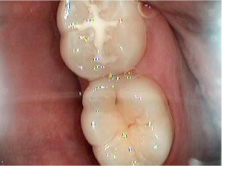 About 90% of the decay found in children’s teeth occurs in surfaces pits and fissures. To solve this problem, dental sealants act as a physical barrier to cavity-causing bacteria invading the pits and fissures.
About 90% of the decay found in children’s teeth occurs in surfaces pits and fissures. To solve this problem, dental sealants act as a physical barrier to cavity-causing bacteria invading the pits and fissures.
A sealant is a plastic resin material applied to the chewing surfaces of the back teeth. This material is bonded into the depressions and grooves (pits and fissures) of the chewing surfaces to protect the enamel from attack by plaque and acids.
The dental practice cleans and dries the teeth to be treated, then paints a thin layer of liquid plastic material on the pits and fissures of the tooth. A blue spectrum light is shone on the material for a few seconds to cure the plastic.[1]
After curing, the plastic forms a hard, thin layer covering the treated portions of the tooth. Despite the incredible pressures placed on teeth during chewing each day, dental sealants often remain effective for five years or longer. If sealants wear or become damaged, they can be repaired or replaced simply by applying new sealant material to the worn or damaged portions.
Children should receive sealants shortly after the eruption of their first permanent molars, around age 6 and again at age 12 when their second molars appear. While the use in children is common, sealants can be used in treating adults as well.
The average cost of a sealant ranges from $42 to $48 dollars per tooth. During your child’s regular dental visits, we check the condition of the sealants and reapply them if necessary.
I know a lot of people still cringe when we talk about dental procedures, but the procedure is painless.
If we can be of service or you have additional questions, do not hesitate to contact us via email or for a complimentary initial consult.
Novy Scheinfeld, DDS, PC
290 Carpenter Drive, 200A
Atlanta (Sandy Springs), GA 30328
404-256-3620
[1] Some brands of sealants cure chemically.

